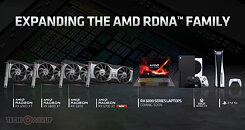This goes through satisfying the customers' needs and requests. Focusing on high margins doesn't necessarily improve a company's financial situation.
AMD needs to find a way to make as many chips as the actual, real demand says.
Getting Navi 22 out the door should be a good step towards this - the smaller die size means dramatically higher numbers of good dice per wafer, so there'll be more GPUs on shelves from the same number of wafers. Navi 21 is ~18x29mm (~520mm²), so let's assume this is more like 18x18mm= 324mm² (the PR die shots/renders look very square, and given memory controllers and other non-CU parts aren't halved, it will be more than half the size of that. Comparing the two in a
wafer yield calculator with known parameters for TSMC 7nm (0.09 defects/CM², standard scribe line and exclusion zone sizes) gives the following output for a 300mm wafer:
Navi 21: 96 complete dice per wafer; 35 with some defect(s), 61 defect-free.
Navi 22: 164 complete dice per wafer; 41 with some defect(s), 123 defect-free.
That's a 2x increase in good dice, and likely the defective ones can be stocked for later binning into lower-end cut-down products once there is sufficient supply. Given what AMD has said about current yields from these GPUs, it seems likely that the defect rate is even below 0.09, or that they have sufficient mitigations in place to be able to use a portion of defective dice for the top SKU as well (hence them not launching a 6700 non-XT (yet)).
Given that this is still at the very upper reaches of consumer pricing ($479 is solidly high-end still, even if it's lower than $579 and $649), there are good chances that supply will actually be all right - though that obviously depends on miners and scalpers. At least Navi 2X is less attractive to miners than Ampere due to the lower memory bandwidth, so that's something. It should perform somewhere around the RTX 3070, after all, so it'll be a very high performance GPU.
Of course the real kicker will be once they get Navi 24 out the door. If that's a ... let's say 28CU die (assuming a cut-down Navi 22 SKU with ~34-36 CUs is slated to arrive at some point) with 64MB of IC and a 128-bit memory interface, that could be a much smaller die again. If they get it down to around 200mm² - let's say 18x11mm, as rectangular dice tend to yield better from what I've read - that would again double per wafer outputs: 282 total dice/wafer; 45 w/defects, 237 defect-free. That would make for a fantastic laptop GPU at reasonable clock (<2GHz), as well as a very attractive 6500 series of GPUs. Hopefully those could deliver some real value in the~$200 segment on desktops as well - if they clock as high as the 6700 XT, a 28CU 6500XT could come pretty close to the 5700 XT in real-world performance.
They're a for-profit business, they need to focus on whatever generates the highest margins. After years of Intel blowing billions to suppress them AMD still needs to grow financially.
That's just accepting the fundamental logical fallacy of the current dominant US(-originated) mode of economics: that margins are somehow not connected to actually delivering attractive products that people want and building customer trust over time. If you have the clout you can squeeze them without doing so, but only for a short while before things come crashing down. If AMD needs to grow financially, they need to do so by building said growth on a solid base of attractive products, high sales volumes, satisfied customers and a solid reputation. They have some attractive products currently, but mostly ones out of the reach of 90% of GPU buyers, meaning they're not getting high sales volumes, (high volumes of) satisfied customers, or a solid reputation from it. There's still a ways to go, and expanding to lower reaches of the market is a necessity for this to happen. The current supply crunch makes the relatively slow launch pace of this generation understandable, but they need to hit the $300 and $200 price points within the next few years if they don't want to risk alienating and disillusioning the vast majority of their customer base.






